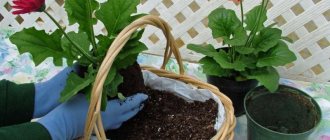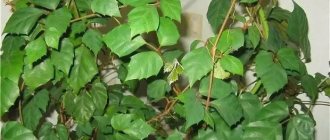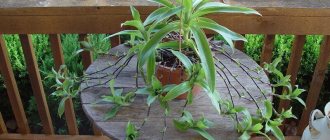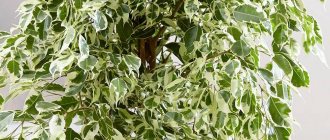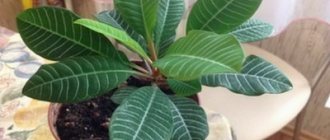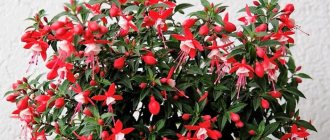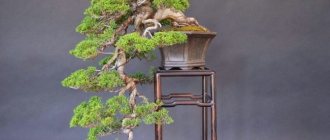Care for gerbera at home
Priming
For the plant, a soil mixture is used, consisting of leaf soil, to which peat or purified sand is added. It is prohibited to add compost and humus to the mixture.
Lighting
Gerbera needs to be protected from direct sunlight, but it must be provided with light, since the plant is a light-loving plant. In summer this is 10–12 hours, and in the cold season fluorescent or LED lamps will help with this.
Temperature
The optimal temperature for gerbera is 20–24 degrees in summer, 14–16 degrees in winter. At a temperature of 12 degrees, the plant slows down its processes, and temperatures below this mark are destructive, as well as excessively high and sudden temperature changes.
Watering
Watering should be carried out with settled water at room temperature. You need to water carefully so that water does not get into the root rosette, so you can use a tray for this.
Bloom
The flowering of gerberas depends on the length of daylight hours; peak activity in gerberas is observed at the end of summer; with the onset of autumn, flowering fades because daylight hours are shortened.
Fertilizer
Gerberas are fertilized during intensive growth, using complex fertilizer for flowering indoor plants or magnesium sulfate. In winter, gerberas are not fertilized.
Gerbera care after flowering
After the gerbera has bloomed, you need to remove dried leaves and flower stalks, and also reduce watering and stop feeding.
Features of care in summer and winter
In summer, the gerbera can be transplanted into an outdoor flower bed, away from direct sunlight, but before transplanting, the plant should be gradually accustomed to this. In winter, gerberas are stored in the basement, where it is dry, the optimal temperature is 6–8 degrees, the roots of the plant are left in the ground to avoid hypothermia.
Growing gerbera from seeds
When purchasing gerbera seeds, you need to pay attention to the expiration date. They remain viable for up to 8 months from the moment of collection, so the grower should not miss this moment.
The optimal time for sowing seeds is spring, but if artificial lighting is possible, then sowing can be done at any time.
Sowing of seeds occurs in the following sequence:
- For sowing, you must first prepare the soil. It should be loose and light, and also consist of peat, sand, perlite and leaf soil. All components are mixed in equal proportions.
- It is necessary to make drainage holes in the planting container and pour expanded clay 3 cm thick.
- Now you should fill up the soil and compact everything.
- Sow the seeds on the surface of the moist soil, lightly pressing them down and sprinkling them with sand.
- Place the container in a warm place with a temperature of 16-20 degrees.
- The planted seeds are ventilated 2 times a day and the soil is moistened as needed - it should always be slightly moist.
- After 8-12 days, the first shoots will appear. After the leaves appear, it is necessary to plant the seedlings into a larger container, maintaining a planting distance of 7-8 cm between them.
- When 5-6 leaves appear, the seedlings must be planted in pots with a diameter of 10 cm. The soil in this case is already made from a mixture: one part each of peat, sand, humus soil, turf soil, two parts leaf soil and a little perlite.
- Replant grown young gerberas into containers with a diameter of 15-20 cm.
Indoor gerberas begin to bloom only 9-11 months after planting and with proper care. If you make minor mistakes in care or replanting, you can significantly delay the flowering period.
Gerbera transplant
Gerbera lives for 3–4 years, during which time it is replanted only a couple of times. After a state of dormancy, with the arrival of spring, the plant is transplanted into a tight pot, but the diameter is increased. It is necessary to remove store-bought soil from the roots, place it in a pot, sprinkle with fresh soil, but so that the base of the roots rises above the ground. After this, the gerbera needs to be watered and fed.
Popular varieties of potted gerbera
Potted gerberas are descendants of Jameson's species and Gerbera viridifolia (green-leaved). Thanks to the work of breeders, many varieties have been developed for growing in pots. Cultivars are usually divided according to the shade and shape of the petals. There are single-color and two-color corollas, simple and terry. The color of the core is varied, but excludes blue tones.
Let's consider several popular varieties of indoor gerbera:
- Pam - deep pink petals framing a red-brown center;
- Valerie - the outer part of the petal is soft pink, the outside is lilac, the core is brown with a double yellow edge;
- Yasmina - yellow center framed by light pink tongues;
- Sophie - this variety has a light core with protruding stamens and red-pink tongues along the edge;
- Rachel - a green core framed by bright scarlet petals;
- Orange - rich orange-colored petals, bright yellow center.
Every year the range of cultivars is replenished with new specimens of miniature gerberas.
Reproduction methods
Reproduction by dividing the bush
Divide the formed plant into several parts, remove the flowers, and trim the roots if necessary. Subsequently, these parts are processed and after a month bushes appear.
Growing from seeds
Spread the seeds over the surface of the peat and cover with a layer of peat or sand. The seeds will sprout in a couple of weeks, and after a month you can harvest them. The gerbera will produce its first flowers in six months.
Reproduction by cuttings
Cut the sections of roots with leaves and plant them so that they take root, the prerequisite being a temperature of about +25 degrees and soil moisture.
Flower propagation by dividing the bush
Indoor cloves - home care
Since the lifespan of this plant is short, and by the end of its life its presentability is also lost, the flowers become small, their number decreases, it is worth thinking about propagating indoor gerberas. This process is simple and is carried out using cuttings, dividing the bush and using seeds. Dividing the bush is the simplest and most common propagation option. The procedure is carried out after the end of summer flowering and before the plant completely goes into a dormant state. The gerbera is pulled out of the pot, the root system is cleaned, and the young roots are divided with sharp, disinfected knives. The number of divisions may vary, but it is important that each of them contains at least 2 growth buds.
Is it possible to propagate a flower by seeds?
The seed method of propagating gerbera is used less frequently, but is still used in practice. Everything happens in the same way as when germinating seeds of other plants: sowing is done in prepared moist soil, the seeds are lightly sprinkled with a layer of soil, covered with film or glass, and placed in a warm, bright place. The greenhouse is periodically opened slightly to moisten the substrate and ventilate. However, there are some nuances. Firstly, the properties of the mother plant are unlikely to be transferred to the daughter, since most varieties are hybrids of Jameson's gerbera. Secondly, the seeds must be freshly collected. Their ability to grow remains only for 4 months after collection. The fresher the seeds, the higher the germination percentage.
Diseases and pests
Table: symptoms of indoor gerbera being affected by diseases and pests, measures to combat them
| Pests or diseases | Pests or diseases | Control measures |
| Powdery mildew | The disease appears as gray or white spots on the leaves, and the stems become covered with a coating of a similar color. | To prevent the appearance of powdery mildew, you can use a solution of soda or mustard, as well as settled onion peels or kefir. Control measures against the pest are as follows: it is necessary to tear off the leaves and cultivate the ground. |
| Gray rot | Gray rot manifests itself in the form of brown spots on the stems and leaves of the plant. The gerbera is starting to rot. | Measures to combat gray mold: reduce watering, cut off infected areas of the plant, and apply chalk or activated carbon to the wounds. |
| Late blight | The disease manifests itself in the form of brown and purple spots. The plant rots. | The disease can be prevented by spraying the soil with garlic infusion. Measures to combat late blight: remove infected plant tissue and all affected tissue. Very often this disease leads to the death of the flower. |
| Fusarium | The disease manifests itself in the drying of the plant stem, the stem turns black, and mold forms on the remaining parts of the plant. | Prevention of fusarium is changing the water with which the plant is watered. Gerbera can be watered with infusion of ash or sulfur. Measures to combat the disease: you can take plant cuttings that are not damaged by the disease. In most cases, there is no treatment and the disease leads to the death of the gerbera. |
| Shchitovka | Signs of the disease are red and yellow spots on the leaves of the plant. Beige and brown growths on the stem of the plant. | As a preventive measure, the soil of the plant is treated with onion or garlic. Measures to combat scale insects: cut off growths on the plant by treating with kerosene or machine oil. After a couple of hours, the applied mixture is washed off with laundry soap. |
| Aphid | Insects appear on the plant, beige dots appear on the gerbera and it begins to dry out. | Prevention involves treating the plant with an infusion of wormwood, lemon, or any other infusion with a distinct odor. Measures to control aphids: in the early stages are similar to prevention; if there is no improvement in the plant, it is necessary to use general-action insecticides. |
| Spider mite | Signs of spider mites on a plant are yellow spots all over the surface and mites on the back of the leaf. | Tear off the already affected leaves and rinse the plant with running water to remove the adults. To destroy the larvae and eggs, you will need to treat the plant several times with insecticides - Fitoverm and Neoron are suitable. |
| Whitefly | Signs of whitewing damage to a plant include yellowing leaves, as well as the presence of many moth-like insects. | As a preventive measure, it is necessary to loosen the soil of the plant more often, and you can also use sticky tape or other similar traps. Measures to combat whitewing include treating gerbera with infusion of wormwood, dandelion leaves or tobacco. |
Diseases, pest control
Gerbera has a strong immune system, but improper care, especially violation of the watering schedule, leads to the development of fungal diseases - powdery mildew, fusarium, various types of rot, late blight. They can be recognized by the appearance of spots of different colors, “powdered” with fungal spores. If you find signs of a fungal disease, remove the infected parts of the bush and spray with a fungicide solution.
Among the pests, indoor gerberas are attacked by spider mites, whiteflies and aphids. By the time they are detected, the pests have time to form a colony and harm the health of the flower. The leafy mass becomes covered with yellow specks, withers, and then dies, depriving the bush of nutrition. A small number of parasites are destroyed with garlic infusion, but a large colony is best destroyed with insecticides.
So, if you follow the care recommendations, your indoor gerbera will delight you with flowering every year. Bright “daisies” will cheer up the chilly autumn and decorate the interior of your home.
Answers on questions
How many gerberas bloom in a pot?
The flowering period of gerbera is from February to June and from August to November.
Why do the leaves turn yellow?
There are several reasons:
- excessive watering, which leads to stagnation of water and provokes the development of rot;
- water getting into the plant outlet when watering;
- soil and air dryness;
- non-compliance with spraying rules;
- watering with cold water.
How to revive a gerbera in a pot
Protect the plant from stress by observing all conditions of care and acclimatization.
How to achieve lush flowering
Comply with the requirements:
- lighting (daylight hours - 12 hours);
- fertilizing (replace fertilizers with mineral ones, which contain phosphorus, potassium nitrate and superphosphate);
- replanting (correct selection of pot sizes).
Is it possible to transplant a gerbera in a pot into open ground?
During the warm period, you can transplant the gerbera into a flowerbed. With the onset of cold weather, you can move it back to the pot.
Main problems when growing
Inexperienced gerbera owners often encounter two growing problems: yellowing leaves and poor flowering. To eliminate them, it is important to know exactly the reasons for the plant’s negative reaction.
Why doesn't gerbera bloom?
Most likely the reason is the size of the pot. Until the gerbera fills the entire container with roots, it will not produce flowers.
Pruning will not help achieve flowering; gerberas do not need it at all. The only thing is do not forget to remove yellowed leaves from the pot, as they can develop a disease that will destroy the entire plant.
Why doesn't it bloom?
In order for the plant to enjoy flowering next season, it is necessary to provide it with a full rest period in winter.
Reasons why gerbera does not bloom:
- The pot chosen was too large when replanting the plant. In this case, the rhizome actively grows, and this draws the flower’s strength away from other processes.
- A pot that is too small is used. The roots do not have enough nutrition.
- The flower is rarely replanted (less than once a year), and the roots do not have time to develop.
- Nitrogen fertilizers are used for feeding. In order for gerbera to bloom well, you need to use potassium and phosphorus.
- The room temperature remains below 12 degrees. In this case, the plant enters a dormant state.
- The plant is over-watered or cold water is used for irrigation. The consequence of such a procedure can be not only the lack of flowering, but also the death of the plant.
Why do the plant's leaves turn yellow?
Three main factors are to blame for the yellowing of gerbera leaves:
- Excess moisture. When the plant is constantly flooded, the respiration of the root system is disrupted, the leaves do not receive enough nutrients and turn yellow. By reducing the intensity of watering and allowing the soil to dry, you can improve the situation.
- Whitefly. The accumulation of white midges under the leaves of the plant and the appearance of white sticky spots means that they have already laid larvae. The leaves of the plant turn yellow, curl and fall off.
- Dry air and soil. Excessive dryness also causes yellowing of the foliage. Restoring normal watering and using a humidifier will resolve the problem.
Video on how to save a dying gerbera from a store:
Pest Control
Like all houseplants, gerberas can also be susceptible to pests. Here are the most common ones:
- The actively reproducing insect on gerbera leaves is the indoor whitefly. The most dangerous are the larvae that feed on plant sap. To get rid of the scourge, you should first wash the leaves with a warm soapy solution, and then spray them with a liquid with a high content of permethrin. In this case, watering is carried out three times a week until the flower has completely recovered.
- If the gerbera suffers from drought, then this is the first prerequisite for the appearance of spider mites, which can be judged by the presence of thin white cobwebs on the plant. In this case, it is enough to spray the gerbera with onion infusion or wipe it gently with medical alcohol. If these methods do not help, it is recommended to resort to using Actellik or Neoron.
- Another pest that feeds on the sap of houseplants is aphids. The danger also lies in the fact that it lives on flowers in large colonies, which are not always noticeable at first glance. If aphids are detected, the gerbera should be treated with Fitoverm, Intavir or Karbofos. After the procedure, the greens must be wiped with a soft cloth soaked in warm water.
Important: if you find pests on a flower, immediately isolate it from all other plants.
How to achieve lush flowering?
The main pride of every gardener is the lush flowering of his pets.
In order for your home gerbera to delight you with bright blooms, you must:
- Provide the plant with 12 hours of daylight. The peak of abundant flowering is from August to November, when the plant has enough natural light. Additional light at other times allows flowering to prolong.
- Feed the flower with mineral fertilizers (potassium nitrate and superphosphate), reducing the number of nitrogen-containing species as much as possible.
- Choose pots that are not too large for planting. When there is excess soil, the plant begins to grow its root system, and it has no strength left to flower.
Types of gerbera
Gerbera can be divided into the following groups according to external characteristics:
Narrow-petaled small-flowered
They have long (up to 0.5 m) peduncles and inflorescences, and the diameter reaches 9 cm. Among the representatives are “Aldebaran” and “Alcor”.
Broad-petaled small-flowered
The peduncles of this species reach a height of 70 cm, and the inflorescences up to 15 cm in diameter. Representatives of this species are “Delios”, “Saturn” and “Vera”.
Narrow petal semi-double and double
Half-meter peduncles, they contain single colored baskets, the diameter of which is about 11 cm. Representatives of the group are “Kalinka”, “Viola” (pink) and “Sonya”.
Narrow-petaled large-flowered
The flower stalks of representatives of this group are up to 70 cm; large inflorescences, reaching up to 13 cm in diameter, are also a distinctive feature. Representatives of the group are “Migar” and “Jupiter”.
Medium-petaled large-flowered
Their distinctive feature is the presence of flower baskets reaching up to 13 cm in diameter on long peduncles. The representative of such an unusual group is “Mars”.
Broad petal semi-double and double
They have peduncles, the length of which does not exceed 70 cm, and inflorescences developing on them with a diameter of 11-14 cm. Representative of the group: variety “Iskra” (dark red, semi-double).
Indoor gerbera is a bright and beautiful plant that requires special care.
If the rules are not followed, it will quickly die, but if you care for the gerbera responsibly, it will delight its owner for a long time. The presence of different types of gerberas allows you to choose a flower, taking into account individual preferences, so that each person will have their own unique indoor gerbera. Did you like the article? Was she helpful?
Description of culture
The genus Gerbera is part of the largest plant family, the Asteraceae. All representatives have a herbaceous habit (appearance), which is hinted at by the name of the genus, which comes from the English word herba - grass. The distribution area of gerberas covers the tropical zone of southern Africa and the islands of Madagascar; several species have been found in Asian countries.
Gerbera forms inflorescence-baskets consisting of two types of flowers. The core is represented by tubular flowers capable of seed reproduction. Along the edges are sterile reed flowers, which many mistakenly consider to be petals. Reed gerbera flowers can be painted in any shades and combinations thereof, excluding the range of blue.
Advice
A houseplant with blue petals is not the result of selection - it acquires this color using a dye. In European countries, gerbera is nicknamed Transvaal chamomile.
Greenhouse gerberas are grown all over the world for cutting. The flower stalks of such plants reach a length of 60 cm. Indoor cultivars are small in size and grow up to 25 cm in height. The bush forms a basal rosette consisting of pinnately dissected leaves of an elongated oval shape. The surface of the plate is pubescent.
A peduncle up to 30 cm long carries a single basket, reminiscent of a large chamomile with a corolla diameter of 4-12 cm. Flowering lasts 3-4 months, accompanied by a rich, pleasant fragrance. The fruits are small achenes that remain viable for up to 6-8 months.
